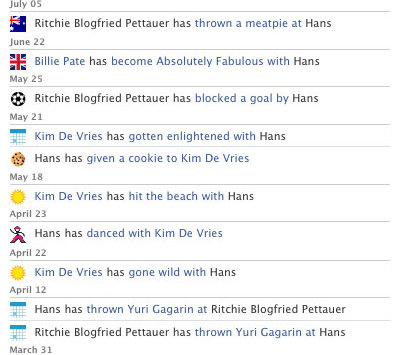Gastbeitrag Kim de Vries: Your Friend has just tackled you
 Haben Sie etwas länger Zeit, als die üblichen 0,22 Millisekunden, in denen man die Inhalte einer Website gemeinhin im Super-Kurzzeit-Gedächtnis abspeichert und quasi in Echtzeit wieder vergisst? Der folgende Beitrag von Kim de Vries befasst sich wissenschaftlich mit einem Phänomen, das wir alle eingehend aus der täglichen Surfpraxis kennen: der symbolischen Kommunikation auf Facebook. Wer noch nie ge-super-poked hat, der schwinge das erste Bein :mrgreen: Ich freue mich jedenfalls außerordentlich über diesen Gastbeitrag von Autorin Dr. Kim de Vries, die an der California State University Stanislaus arbeitet. Wir liefen uns auf Facebook über den Weg, wo sich sozusagen unsere Poke-Radien überschnitten. Kim wiederum kennt so unzwielichtige Gestalten wie meine Studienkollegen Bernhard Rieder und Mirko Tobias Schäfer: die Welt ist also online und offline klein. Aber genug der einleitenden Worte – allen Kommunikationswissenschaftlern und interessierten Beobachtern aktueller Geschehnisse wünsche ich viel Vergnügen mit der folgenden Lektüre.
Haben Sie etwas länger Zeit, als die üblichen 0,22 Millisekunden, in denen man die Inhalte einer Website gemeinhin im Super-Kurzzeit-Gedächtnis abspeichert und quasi in Echtzeit wieder vergisst? Der folgende Beitrag von Kim de Vries befasst sich wissenschaftlich mit einem Phänomen, das wir alle eingehend aus der täglichen Surfpraxis kennen: der symbolischen Kommunikation auf Facebook. Wer noch nie ge-super-poked hat, der schwinge das erste Bein :mrgreen: Ich freue mich jedenfalls außerordentlich über diesen Gastbeitrag von Autorin Dr. Kim de Vries, die an der California State University Stanislaus arbeitet. Wir liefen uns auf Facebook über den Weg, wo sich sozusagen unsere Poke-Radien überschnitten. Kim wiederum kennt so unzwielichtige Gestalten wie meine Studienkollegen Bernhard Rieder und Mirko Tobias Schäfer: die Welt ist also online und offline klein. Aber genug der einleitenden Worte – allen Kommunikationswissenschaftlern und interessierten Beobachtern aktueller Geschehnisse wünsche ich viel Vergnügen mit der folgenden Lektüre.
Kim de Vries: Your Friend has just tackled you
Bite, lick, or tackle them back, or click here to theorize about what this all means.
Introduction
Though Facebook was initially the province of college students, it has become popular with a broad range of users since opening its door to anyone with an email address in September 2006. However, until very recently, most research on Facebook has focused on the student demographic rather than exploring how Facebook is growing into a massive online society that is inhabited by many different groups using Facebook in a variety of ways for a variety of reasons. The academics studying Facebook generally join it and use it in order to observe students; now that more faculty are using Facebook outside the classroom, to organize events and to socialize, turning the focus to our own use of Facebook reveals that our own communities are being affected as well.
As of August 2008, Facebook is one of the most rapidly growing social networks, boasting 100 million active users, translated into twelve European and a growing number of Asian and African languages. The extent to which groups of people connected on Facebook can be defined as communities is highly debatable and a useful alternative has been suggested by Rieder and Schäfer: „forms of interaction and collaboration characterized by fleeting encounters, transient teamwork and weak ties – social spaces that may or may not evolve into more stable forms of sociability (2007).“ They go on to propose considering these social spaces as „hybrid foam,“ with foam’s ephemeral qualities. But when Facebook connections occur between people already connected in other ways, such as professionally, it may act as a stabilizing agent, encouraging those connections to become stronger and more permanent.
Analyzing the kinds of communication that differ from the textual exchanges common via email, blogging and commenting, online forums and so forth shed light on what may occur when we begin to Connect with our colleagues through Facebook. Facebook provides novel and amusing ways for people to connect. More importantly, the connections feel more embodied, so that users may believe they are getting to know people in a more personal way than through an email list or chat room. Participants may also be more inclined to display ludic behavior because by virtue of meeting on Facebook, which is a rather un-serious place, a certain level of playfulness is assumed. However, the fact remains that while we may participate in a variety of communities via Facebook, including fan, artistic, social, familial, and professional, these traces of this communication may be visible to all of our communities, though the communications may only be appropriate to one. Thus, our participation in various spheres actually does not happen in separate ‚bubbles‘ but may in an additional way be considers as a sort of foam in which there may be shared borders or interpenetrating cells.
Because various social spheres may interpenetrate on Facebook, academics who participate there risk crossing social boundaries. Just as we warn our students, we have to consider who we add as friends and what they can see us doing. A number of articles have recently focused on the risk of losing students‘ respect by using Facebook, yet this does not seem to stop most faculty from using Facebook. And what about what our colleagues may see? What do we gain from taking these communicative risks online, and how is our use of Facebook to communicate and form social connections affecting offline scholarly communities?
These are vast questions and providing a comprehensive answer is beyond the scope of this paper, but considering an exemplary case will suggest what possibilities might be profitably investigated.
Approach
Kenneth Burke’s pentad provides a helpful framework with which to understand communication (Burke 1945). According to Burke, any human interaction (or text) may be analyzed in terms of five elements framed as these five questions:
- Act: What purposeful act has taken place?
- Agent: Who took this action?
- Agency: How or with what did they do it?
- Scene: Where, when and in what context did the act take place?
- Purpose: Why did they do it? What was their intent?
Rhetorical analysis is then performed by examining the how pairs of the elements function within the interaction or text, and by demonstrating how one member of the pair determines the other member’s nature. The results of such an analysis may reveal contradictions between what is stated by a rhetor (writer, actor, or speaker) and what is supported with the rhetorical evidence he or she presents. In this case however, the issue is not that people on Facebook are trying to willfully mislead each other (though some may be trying to), but rather that the intentions of users in carrying out actions are not the same as the intentions of designers in promoting the same actions, nor are the interpretations of recipients necessarily accurate.
Though communication is always mediated, in the case of Facebook, the physical distance and the interface my both introduce distortions into our understandings of each other, even while creating the impression that we are getting to know each other very well indeed. Performing a rhetorical analysis will help shed some light on how scholars are connecting on Facebook, and on how these connections are affecting our communities. Ultimately we may see that our professional networks are actually being changed by an online interface.
Further, Facebook may be more generally contributing to the development of hybrid agency, shared between user and system. For academics to be come conditioned to this hybrid agency may have quite important implications as well. To explore these issues, and exemplary analysis of some members‘ use of the Superpoke application was conducted.
The Five Elements to be Analyzed:
Act
The acts being considered are communications through Facebook applications, and an exchange of Superpoke gestures is the exemplary case. The specific gestures vary, and this variation makes clear that the definition of an „act“ is complicated when it is virtual, not actual. Wishing someone „happy birthday“ can be expressed through a variety of media without the message varying much, but slapping someone with a trout would be very different if carried out in person; it’s virtual meaning depends on the fact that it is virtual.
Agent
The most obvious agents are Facebook users, but arguably the system itself and the developers become agents in the way they channel user actions. Each user chooses how and when to communicate, but the system encourages certain actions by frequently reminding users to respond to communication of another user; by suggesting certain actions — like explicitly choosing to have a gesture featured in the newsfeed; and by rewarding a higher volume of communication generally.
Agency
In one sense, members use their own agency–they decide how to communicate. But on Facebook, members use the Facebook platform to communicate, in particular choosing from an array of applications which offer limited choices and in that way channel user behavior. In this case the Superpoke application allows users to make a variety of gestures, largely physical/audible toward one another. A gesture may be sent either to one friend from the user’s friend list, or broadcast to many. Depending on how both sender and receiver have set their privacy options, the gesture may be reported in the Newsfeed (on the member profile page) and on the Minifeeds of each members‘ friends. Arguably we see and emergent hybrid agency developing in all of these applications, that combines user agency with that of the system and the developers.
Scene
The scene is the Facebook platform, specifically the profile and home pages of the members engaged in the exchange. However, thanks to applications like Plaxo and Friendfeed, which collect social network news across platforms, the gestures maybe re-posted outside of Facebook. Further, the news of the gestures maybe discussed in other venues–in blogs, email, in person–so that the borders of the scene are fluid. The permanence of the gestures, forever recorded, marks a sharp distinction to the real-life actions they mimic.
Purpose
Possible explanations for participants‘ devotion to Facebook and willingness to play are suggested by recent research on the problem of establishing co-presence online (Zhang 2007), how embodiment and presence are experienced in online communities (Marshall 2004), and through consideration of the hybrid foam metaphor recently suggested as a replacement for network (Schäfer 2007). Application developers also have their own purposes, the primary being to encourage more and ongoing use of the application.
Analysis
Purpose is a key element in this analysis because participant interpretation of each other’s purposes shapes the idea each forms of the other’s personality and identity. Further, because online sociality functions in some ways differently from sociality enacted in person, understanding participant motives depends on understanding those differences. Finally, participant purpose is always channelled by the design, and so it always echoes the developers‘ purpose to some degree. The analysis begins with the participants‘ purpose, because this purpose underlies not just use of Superpoke, but of Facebook more generally.
Jonathan Marshall has argued that participants in online communities often experience „asence“ or ontological uncertainty experienced online because „there is no marker of existence beyond the act of communication itself (Marshall 2004).“ Facebook differs not only in combining the permanence of the homepage/profile with email- and bulletin board- like functions, but especially in offering games and other applications that mimic physical experiences and leave highly visible traces. Thus on Facebook even if participants are not in steady communication, asence is reduced.
A striking aspect of this shift is the transgressive behavior often exhibited as a matter of course inside Facebook toward those who are colleagues and may become friends. Marshall has suggested that members of online communities may use sexual behavior to establish intimacy and maintain contact, much more so than in face-to-face relationships. Many email lists explicitly warn participants away from overly personal chatter, but this stricture would seem at best counter-productive and at worst stodgy in an environment like Facebook. The flirtatious tone of many Facebook applications may attract users because it perfectly addresses this already established mode of online communication. the appearance of this dynamic in a space that is at least partially professional however, is a shift, and may seem far-fetched to those who have not experienced it. This flirtatious dynamic can be seen clearly with some of the most popular applications.
The Superpoke application allows users to send gestures and actions to friends who have also added Superpoke. The possibilities range from seasonal or holiday greetings, to romantic or sexual acts, to mean or even violent gestures. Wishing someone Happy Chinese New Year is fairly unequivocal, but the actual meaning expressed when one user licks, tackles, whips or throws a sheep at another is open to a wide range of interpretation and sexual innuendo can easily be conveyed. In addition to strengthening a feeling of intimacy through flirtatious behavior, ambiguity may also contribute to making Superpoke seem entertaining to scholarly types; every message or a series of them can be treated as a puzzle to be solved or a cypher to be decoded.
But whatever else is accomplished when these message are exchanged, the goals of the developers are always fulfilled, so long as communication continues.
Examples of Superpoke Exchanges
Ambiguous communicative motives may be observed in the Superpoke feed of Hans Bernhard, a member of the artist group Übermorgen.

If each of the five elements are considered in this exchange, on the surface, agent varies according to who sent the poke, and motive may vary as implied by the different actions chosen. In choosing to use Superpoke instead of text, the participants in the exchange have already opted for a potentially more ambiguous mode of communication, and also one that „feels“ more embodied. In the above history of gestures, we see some that are sociable and friendly, such as dancing, giving cookies, hitting the beach, or finding enlightenment. But we also see some that are ambiguous, like throwing Yuri Gagarin or hypnotizing, and some that are downright naughty, like spanking, taking sexy pictures, and going wild. Complicating the interpretive task for participants is the accumulation of gestures, how the gestures directed at one friend compare to those directed at another, and each member’s cultural awareness of what gestures mean. In spite of ample room for misunderstanding, exchanging gestures often leaves the people involved feeling they are getting to know each other much better than if they were simply exchanging text messages. Further, because the gestures occur in what is already defined as a friendship (because participants must be on each other’s friends list) apparent hostility must be assumed as humor, while flirtation may be meant as a joke, or meant seriously. However when we say „seriously about virtual actions, what doers this mean? Were we meeting in person, I would not in fact be able to hypnotize Hans, nor would R. Pettauer be able to toss a long dead astronaut at him. So along with always being already defined as friendly, these actions are also always part of a game the participants play together.
This kind of playful activity seems especially concentrated during times when in a relationship carried out in person, participants might normally meet, whether because of a specific event, like a birthday, or because the relationship is advancing. For example, the following brief but concentrated exchange took place between myself and a fellow internet scholar two days after meeting at a conference at which we’d spent a few hours after the banquet drinking and talking shop, but hadn’t had any further chance to meet for more than a few minutes.

It does not appear to be a very friendly exchange, but in fact carries on the humorous tone already established when we met face to face, and though brief, this exchange served to confirm our initial impressions of each other. Trout-slapping evokes a sort of slap-stick humor, while a restraining order is a melodramatic over-reaction, and so also humorous. A hadouken references an aspect of Asian culture that would be known to fans of videogames, Japanese Anime, or Hong Kong action movies, so the gesture invites acknowledgement of a shared interest.
This may sound quite cozy and altogether positive; two colleagues maintain a connection rather than not. And in fact, it may in some ways be positive since, to continue this example, David and I are slowly moving toward working on some Facebook research together. However,we are also following a path laid out by the Superpoke developers and as we follow that path, we are becoming more and more conditioned to conducting parts of our professional exchanges in the game world, according to it’s rules. Of course, users are not thinking of this when they choose what to do; they are thinking of how much they enjoy feeling more connected and as explained below, this has been an ongoing issue in online sociality.
The Importance of Being Together, or at Least Feeling Like You Are
When friendships form online, they often reach a moment when the new friends would meet face-to-face and the relationship would be carried out offline as well, but when this is prevented by distance or any other factor, the online channels must carry quite a load of information and feeling, which may serve to intensify the virtual exchanges (Marshall). Participants in this kind of relationship often become extremely intimate on an emotional level because physical intimacy is impossible. Note though that this does not only apply to romantic or sexual relations, but to all connections. With those who are physically proximal, we can easily exchange hugs or handshakes, share meals, go to museums or engage in hundreds of other physical activities which because they are public and common may not seem terribly significant or intimate. But shared physical experiences of any kind cement bonds between people, and also reveal a great deal about the participants to each other. We have an ongoing feeling of being together, or ‚co-presence” (Zhang 2007). In many ways the exchanges on Facebook seem to stand in for physical encounters–going to lunch or for drinks, attending cultural events, etc.
Superpoke provides a selection of actions that users choose from in order to express interests, political views, flavors of humor, and so on. But any action can be intended seriously, or ironically (or both). Understanding each other’s motives becomes paramount because compressing all contact into an online channel intensifies the exchange, and the more effort users expend in interpretation, the more committed they are to the exchange. So by offering some actions that may be cryptic to some users and require them to make an interpretive effort, developers increase the odds that users will continue the exchange.
Of course not everyone uses Superpoke, but similar exchanges can be observed in Boozemail, Free Gifts, Hug Me, and numerous other applications. Further, as has been pointed out, playing a game conditions us to the game-world or system. In this case Facebook conditions us to a world in which we interact playfully with everyone, whether they are friends or colleagues, shifting the tone of all these relationships in a more playful and sometimes transgressive direction. Playing with others we feel we get to know them better. In addition to asence being reduced and co-presence maintained between individuals, this occurs also in groups and communities.
It seems the playful or ambiguous tone prompted by Superpoke and other applications has influenced professional communities on Facebook, such as the intriguingly titled ‚Critical Theory and Theorists are Hot.‘ In fact, many serious scholarly groups now have a presence on Facebook, such as the Institute for Distributed Creativity; Theory.Org; the Electronic Literature Organization; the Society for Literature, Science, and the Arts; and of course the Association for Internet Researchers, to name just a few. On the last for example, members can identify who else is attending the conference and find any friends shared in common, which may create a stronger feeling of belonging in the group. In these groups, members interact through wall posts or forum discussions in a manner that may feel more embodied and ‚authentic,‘ and especially in conjunction with the other interactions facilitated and even prescribed by Facebook applications that we see a real shift in the way we are meeting and establishing hybrid social/professional relationships. But do we really get to know people in the same way as we would interacting in person, or if not, what impact does the difference have on our personal/professional connections?
Implications
Several applications offer to illustrate a user’s social connections, often with the implication that by collecting all kinds of data, some revelation will be found in the subsequently generated map. In fact examining the Facebook application „Nexus“ reveals that though network visualization applications are supposed to reflect participants‘ social connections, they often offer a distorted view, suggesting that Facebook itself may offer a distorted view. Facebook seems to allow certain kind of expansion of user’s social network. For example, the Nexus screenshot below appears to show a dense network among some of my friends/colleagues, with some connections leading out of the frame from Monty Cantsin and Karen Elliot.

Were we to expand the picture, we would find that Monty Cantsin and Karen Elliot connect this cluster to two other dense cluster of my friends. However, both of those „people“ are fictional. Any user can of course see where these kinds of representations are distorted in their own relations, but from the outside, there is no way to know how accurate they are, unless one has the offline knowledge to draw on. In this case, not everyone would know that „Monty Cantsin“ is in fact not a real person. Further, unless they are well known in person, even people in one’s own network may interpret notices from Facebook applications that they share movie taste, life goals or other preferences as accurate representations, but are they? In many ways distortions may be introduced that are not discovered until a relationship moves beyond the prescribed interactions of Facebook applications to actual conversation or meeting in person. But seeing behavior that in its playfulness or apparent intimacy is occasionally inappropriate may lead people to perceive it as more authentic and the person observed as more candid and „real.“
(In)conclusions
This preliminary analysis suggests that Facebook is affecting our communication practices and our communities in several ways. First of all, the rhetorical analysis reveals that while Facebook applications appear to simplify the rhetorical situation by reducing the number of variable elements, in fact the remaining elements become harder to interpret, and agency is divided between users, the system, and developers. Second, because the applications channel user actions in a more playful direction, they condition users into coming to expect this kind of playful exchange and to engage in it themselves across social spheres, rather than distinguishing between them. Third, though these exchanges reduce asence, strengthen feelings of co-presence and make participants feel they know each other better, when not combined with face to face interaction, the opportunity for misperceptions is great.
These conclusions need to be verified and elaborated trough study of a much larger sample, but a challenge in conducting this research is data collection. Because most Facebook users restrict their profiles to friends, observing a representative sample becomes quite difficult. While surveys are being attempted, relying on self-reported behavior has some problems. The best approach now seems to design a Facebook application and that represents the next step proposed in order to determine the wider impact on scholarly communities and connections.
In spite of the risks of transgression and distortion, forming connections that are playful and emotionally more intimate can be positive in personal and professional terms. People with whom we have formed multi-valent relationships online may also become people with whom we might collaborate on research, or organize conference panels, or at least go to for advice when visiting their home countries/cities. If the kind of communication fostered by Facebook does indeed promote these kinds of connections, that will have a profound impact on scholarly communities. Until now, in spite of the ease of communication offered by the Internet, when it comes to collaborative work, „space still matters (Borner 2007).“ Thus I ultimately argue that we are making a deal with the devil: users sharing playful and even transgressive exchanges strengthen their social and professional bonds. In circles where communication is often ephemeral, limited to a brief chat at a conference reception or an exchange on a mailing list, Facebook may be especially attractive. But as we use this amusing and useful platform, we are first and always fulfilling the purpose of developers who don’t care what we say, as long as we keep talking.
Bibliography
- Boyd, Danah. „Choose Your Own Ethnography: In Search of (Un)Mediated Life.“ Paper presented at 4S, Montreal, Canada, October 13, 2007. http://www.danah.org/papers/talks/4S2007.html
- Burke, Kenneth. A Grammar of Motives. Berkeley: U of California Press, 1945.
- Börner, Katy. „Towards Scholarly Marketplaces“ at New Network Theory International Conference, Amsterdam, The Netherlands, June 29, 2007.
http://ivl.slis.indiana.edu/km/pres/2007-borner-mktplc-ucsd.pdf - Marshall, Jonathan. “The Online Body Breaks Out? Asence, Ghosts, Cyborgs, Gender, Polarity and Politics.” Fibreculture Issue 3, 2004. http://journal.fibreculture.org/issue3/issue3_marshall.html
- Rieder, Bernhard and Mirko Tobias Schäfer. Hybrid Foam. Social Structure before Network and Community, Paper presented at the BSA Annual Conference 2007, London, April 13 2007.
- Zhao, Shanyang & Elesh, D. „Copresence as ‘Being With’: Social Contact in Online Public Domains.“ Information, Communication & Society, V. 11, No. 4 June 2008, pp 565-583.
- Zimmerman, Eric. “Narrative, Interactivity, Play, and Games,” First Person. MIT Press: 2004, remediated at http://www.electronicbookreview.com/thread/firstperson
- Facebook – http://www.facebook.com










Trackbacks & Pingbacks
… [Trackback]
[…] Read More here to that Topic: datenschmutz.net/gastbeitrag-kim-de-vries-your-friend-has-just-tackled-you/ […]
Hinterlasse einen Kommentar